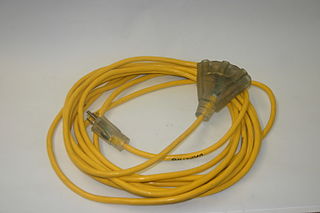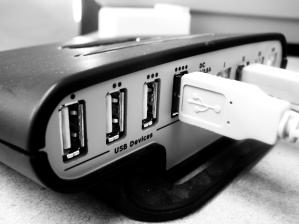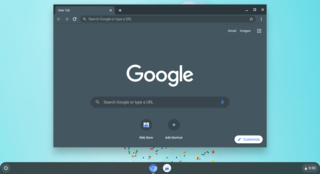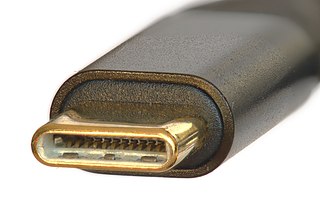Related Research Articles

Universal Serial Bus (USB) is an industry standard that establishes specifications for cables, connectors and protocols for connection, communication and power supply (interfacing) between computers, peripherals and other computers. A broad variety of USB hardware exists, including 14 different connector types, of which USB-C is the most recent and the only one not currently deprecated.

An extension cord (US), power extender, drop cord, or extension lead (UK) is a length of flexible electrical power cable (flex) with a plug on one end and one or more sockets on the other end. The term usually refers to mains extensions but is also used to refer to extensions for other types of cabling. If the plug and power outlet are of different types, the term "adapter cord" may be used. Most extension cords range from around two to thirty feet in length although they are made up to 300 feet in length.
Direct Cable Connection (DCC) is a feature of Microsoft Windows that allows a computer to transfer and share files with another computer, via a connection using either the serial port, parallel port or the infrared port of each computer. It is well-suited for computers that do not have an ethernet adapter installed, although DCC in Windows XP can be configured to use one if available.

A USB hub is a device that expands a single Universal Serial Bus (USB) port into several so that there are more ports available to connect devices to a host system, similar to a power strip. All devices connected through a USB hub share the bandwidth available to that hub.

Advanced Configuration and Power Interface (ACPI) is an open standard that operating systems can use to discover and configure computer hardware components, to perform power management, auto configuration, and status monitoring. First released in December 1996, ACPI aims to replace Advanced Power Management (APM), the MultiProcessor Specification, and the Plug and Play BIOS (PnP) Specification. ACPI brings power management under the control of the operating system, as opposed to the previous BIOS-centric system that relied on platform-specific firmware to determine power management and configuration policies. The specification is central to the Operating System-directed configuration and Power Management (OSPM) system. ACPI defines hardware abstraction interfaces between the device's firmware, the computer hardware components, and the operating systems.

USB 3.0, released in November 2008, is the third major version of the Universal Serial Bus (USB) standard for interfacing computers and electronic devices. Among other improvements, USB 3.0 adds the new transfer rate referred to as SuperSpeed USB (SS) that can transfer data at up to 5 Gbit/s, which is about 10 times faster than Hi-Speed. It is recommended that manufacturers distinguish USB 3.0 connectors from their USB 2.0 counterparts by using blue color for the Standard-A receptacles and plugs, and by the initials SS.

DisplayLink is a semiconductor and software technology company. They develop the DisplayLink USB graphics technology, which is designed to connect computers and displays using USB, Ethernet, and WiFi. It also allows multiple displays to be connected to a single computer. DisplayLink's primary customers are notebook OEMs LCD monitor manufacturers and PC accessory vendors supporting the Microsoft Windows, macOS, Android, ChromeOS and Linux operating systems.

ChromeOS, sometimes stylized as chromeOS and formerly styled as Chrome OS, is a Linux-based operating system designed by Google. It is derived from the open-source ChromiumOS and uses the Google Chrome web browser as its principal user interface.

ChromiumOS is a free and open-source operating system designed for running web applications and browsing the World Wide Web. It is the open-source version of ChromeOS, a Linux-based operating system made by Google.

IEEE 1394 is an interface standard for a serial bus for high-speed communications and isochronous real-time data transfer. It was developed in the late 1980s and early 1990s by Apple in cooperation with a number of companies, primarily Sony and Panasonic. Apple called the interface FireWire. It is also known by the brand names i.LINK (Sony), and Lynx.

Porteus is a portable operating system based on Slackware. It does not require installation and can be run from fixed and removable media, such as a USB flash drive or compact disc.

A Chromebook is a laptop or tablet running the Linux-based ChromeOS as its operating system. Initially designed to heavily rely on web applications for tasks using the Google Chrome browser, Chromebooks have since expanded to be able to run Android and full-fledged Linux apps since 2017 and 2018, respectively. All supported apps can be installed and launched alongside each other.

A stick PC or PC on a stick is a single-board computer in a small elongated casing resembling a stick, that can usually be plugged directly into an HDMI video port. A stick PC is a device which has independent CPUs or processing chips and which does not rely on another computer. It should not be confused with passive storage devices such as thumb drives.
The Chromebook Pixel is a 2013 laptop at the high end of Google's Chromebook family of machines, which all come preinstalled with ChromeOS operating system. The Chromebook Pixel is part of the Google Pixel series of consumer electronics. An updated model was released in 2015. Chromebook Pixel stopped receiving software and security updates in August 2018.

USB-C is a 24-pin USB connector system with a rotationally symmetrical connector. The designation C refers only to the connector's physical configuration or form factor and should not be confused with the connector's specific capabilities, which are designated by its transfer specifications. A notable feature of the USB-C connector is its reversibility; a plug may be inserted into a receptacle in either orientation.

Fuchsia is an open-source capability-based operating system developed by Google. In contrast to Google's Linux-based operating systems such as ChromeOS and Android, Fuchsia is based on a custom kernel named Zircon. It publicly debuted as a self-hosted git repository in August 2016 without any official corporate announcement. After years of development, its official product launch was on the first-generation Google Nest Hub, replacing its original Linux-based Cast OS.
The Pixelbook is a portable laptop/tablet hybrid computer developed by Google which runs ChromeOS. It was announced on October 4, 2017, and was released on October 30. In September 2022, Google canceled future generation of the product and dissolved the team working on it.
The initial versions of the USB standard specified connectors that were easy to use and that would have acceptable life spans; revisions of the standard added smaller connectors useful for compact portable devices. Higher-speed development of the USB standard gave rise to another family of connectors to permit additional data paths. All versions of USB specify cable properties; version 3.x cables include additional data paths. The USB standard included power supply to peripheral devices; modern versions of the standard extend the power delivery limits for battery charging and devices requiring up to 100 watts. USB has been selected as the standard charging format for many mobile phones, reducing the proliferation of proprietary chargers.

USB3 Vision is an interface standard introduced in 2013 for industrial cameras. It describes a specification on top of the USB standard, with a particular focus on supporting high-performance cameras based on USB 3.0. It is recognized as one of the fastest growing machine vision camera standards. As of October 2019, version 1.1 is the latest version of the standard.

USB4 is a specification by the USB Implementers Forum (USB-IF), which was released in version 1.0 on 29 August 2019. The USB4 protocol is based on the Thunderbolt 3 protocol; the Thunderbolt 3 specification was donated to the USB-IF by Intel Corp. The USB4 architecture can share a single high-speed link with multiple end-device types dynamically, best serving each transfer by data type and application.
References
- 1 2 Raphael, JR. "How I Use Android: Google engineer and USB-C crusader Benson Leung". Computerworld. No. 2015. IDG Communications. Retrieved 3 July 2021.
- ↑ "Linux kernel Maintainers file". git.kernel.org. Retrieved 4 July 2021.
- ↑ Hollister, Sean (28 Feb 2016). "Should you fear your USB cable?". CNET. Red Ventures. Retrieved 4 July 2021.
- ↑ Thomson, Iain (3 Feb 2016). "'Dodgy Type-C USB cable fried my laptop!'". The Register. Retrieved 3 July 2021.
- ↑ Gibbs, Samuel (15 Feb 2016). "Apple to replace faulty MacBook USB-C charging cables". The Guardian. Guardian News & Media Limited. Retrieved 4 July 2021.
- ↑ Gibbs, Samuel (30 Mar 2016). "Amazon clamps down on dangerous, laptop-destroying USB-C cables". The Guardian. Guardian News & Media Limited. Retrieved 4 July 2021.
- ↑ Lawler, R (4 Nov 2015). "Google engineer takes on subpar USB Type-C cables". Engadget. Verizon Media Inc. Retrieved 4 July 2021.
- ↑ Amadeo, Ron (9 Jul 2019). "Raspberry Pi admits to faulty USB-C design on the Pi 4". Arstechnica. Condé Nast. Retrieved 3 July 2021.